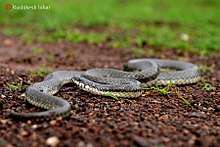Gerarda prevostiana
Gerarda prevostiana, commonly known as the cat-eyed water snake, Gerard's water snake, or the glossy marsh snake, is a species of snake in the family Homalopsidae. The species is endemic to Asia. It is the only species in the genus Gerarda.
| Gerarda prevostiana | |
|---|---|
 | |
| Scientific classification | |
| Kingdom: | Animalia |
| Phylum: | Chordata |
| Class: | Reptilia |
| Order: | Squamata |
| Suborder: | Serpentes |
| Family: | Homalopsidae |
| Genus: | Gerarda Gray, 1849 |
| Species: | G. prevostiana |
| Binomial name | |
| Gerarda prevostiana | |
| Synonyms | |
Etymology
The generic name, Gerarda, is in honor of someone named "Gerard". Unfortunately, Gray, who named the genus in 1849, did not specify whom he was honoring. Two possibilities are Adam Gerard or Rev. Gerard R. Smith, both of whom sent specimens of reptiles to Gray at the British Museum.[4]
The specific name, prevostiana, is in honor of French naturalist and illustrator Florent Prévost.[4]
Diet
G. prevostiana feeds almost exclusively on crabs, which it tears into bite-sized pieces by pulling them through its coils, in contrast to most other snakes which swallow their prey whole.[5][6][7]
Description
G. prevostiana has the following scalation. The frontal is a little longer than broad, shorter than its distance from the end of the snout, or than the parietals. The loreal is slightly longer than deep, a little smaller than the nasal. There is one preocular, and there are two postoculars. The temporals are arranged 1+2. There are eight upper labials, the fourth entering the eye. Four of the lower labials are in contact with the anterior chin shields. The anterior chin shields are much larger than the posterior chin shields. The dorsal scales are in 17 rows at midbody. The ventrals number 146–158. The anal is divided. The subcaudals number 31–34.[8]
The body is uniform dark olive above, with three outer rows of scales whitish. The upper lip is white, and the rostral is dark olive. The ventrals and subcaudals are whitish, with dark edges.[8]
The total length is 41 cm (16 inches), including the tail which is 5 cm (2 inches) long.[8]
Geographic range
G. prevostiana is found in Bangladesh, India, Malaysia (Peninsular Malaysia), Myanmar (= Burma), Philippine Islands (Mindanao), Singapore, Sri Lanka, and Thailand.
References
- Eydoux F, Gervais P (1837). "Voyage de la Favourite. Reptiles ". Mag. Zool. Guérin, Paris III: 1-10. (Coluber prevostianus, new species, p. 5). (in French).
- Gerarda prevostiana at the Reptarium.cz Reptile Database. Accessed 16 February 2020.
- Boulenger GA (1896). Catalogue of the Snakes in the British Museum (Natural History). Volume III., Containing the Colubridæ (Opisthoglyphæ and Proteroglyphæ) ... London: Trustees of the British Museum (Natural History). (Taylor and Francis, printers). xiv + 727 pp. + Plates I-XXV. (Genus Gerardia [sic], p. 20; species G. prevostiana, pp. 20-21).
- Beolens, Bo; Watkins, Michael; Grayson, Michael (2011). The Eponym Dictionary of Reptiles. Baltimore: Johns Hopkins University Press. xiii + 296 pp. ISBN 978-1-4214-0135-5. (Genus Gerarda, p. 99; species G. prevostiana, p. 211).
- Jayne BC, Voris HK, Ng PKL (2002). "Snake circumvents constraints on prey size". Nature 418: 143.
- Main D (2018-04-06). "This Snake Rips Its Prey Into Pieces, Instead of Swallowing it Whole". National Geographic. Retrieved 2018-04-09.
- Jayne BC, Voris HK, Ng PK (2018). "How big is too big? Using crustacean-eating snakes (Homalopsidae) to test how anatomy and behaviour affect prey size and feeding performance". Biological Journal of the Linnean Society. 123 (3): 636–650. doi:10.1093/biolinnean/bly007.
- Boulenger GA (1890). The Fauna of British India, Including Ceylon and Burma. Reptilia and Batrachia. London: Secretary of State for India in Council. (Taylor & Francis, printers). xviii + 541 pp. (Gerardia [sic] prevostiana, p. 379).
Further reading
- Das I (2002). A Photographic Guide to Snakes and other Reptiles of India. Sanibel Island, Florida: Ralph Curtis Books. 144 pp. ISBN 0-88359-056-5. (Gerardia [sic] prevostiana, p. 35).
- Gray JE (1849). Catalogue of the Specimens of Snakes in the British Museum. London: Trustees of the British Museum. (Edward Newman, printer). xv + 125 pp. (Gerarda, new genus, p. 77).
- Smith MA (1943). The Fauna of British India, Ceylon and Burma, Including the Whole of the Indo-Chinese Sub-region. Reptilia and Amphibia. Vol. III.—Serpentes. London: Secretary of State for India. (Taylor and Francis, printers). xii + 583 pp. (Gerardia [sic] prevostiana, pp. 394–396 + Figures 125-126).
- Wall F (1921). Ophidia Taprobanica or the Snakes of Ceylon. Colombo, Ceylon [Sri Lanka]: Colombo Museum. (H.R. Cottle, Government Printer). xxii + 581 pp. (Gerardia [sic] prevostiana, pp. 262–265, Figure 53).
